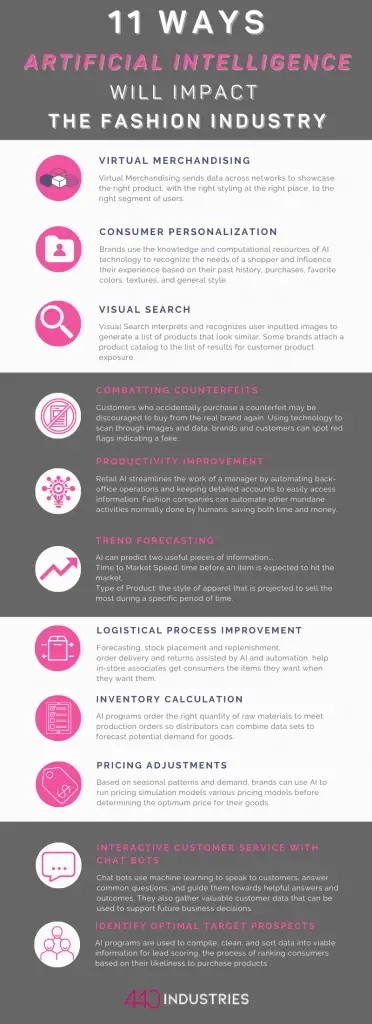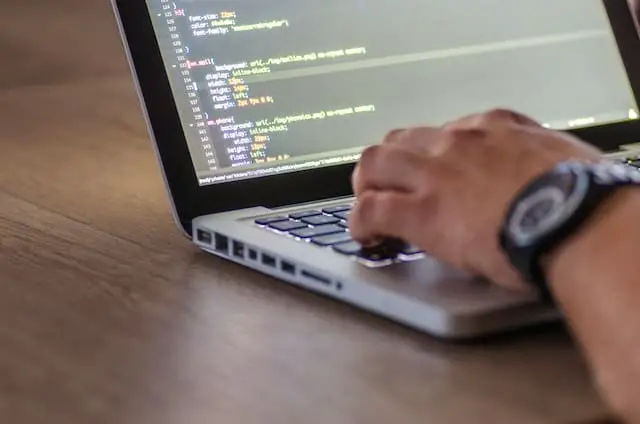Introduction
Artificial Intelligence (AI) has swept through a range of sectors with the ability to revolutionize companies through innovative technology, more efficient operational processes, and access to customer and industry insights that offer a promising competitive advantage.
For an industry built upon creative abilities and expression, AI automation did not seem like an attractive tool for fashion leaders to use at first. However, as we move into a hyper-digital age, these applications have the ability to transform businesses to generate significant industry growth and revenues compared to competitors using traditional methods.
Let’s take a look at these various AI applications and how businesses are developing customized strategies to supplement their specific business models.
1. Visual Merchandising
2. Consumer Personalization
3. Visual Search
4. Combatting Counterfeits
5. Productivity Improvement
6. Trend Forecasting
7. Logistical Product Improvement
8. Inventory Calculation
9. Pricing Adjustments
10. Interactive Customer Service with Chat Bots
11. Identify Optimal Target Prospects
12. Conclusions
1. Visual Merchandising
Fashion brands have long recognized the value of the design of the shop floor to attract consumers. Much as the diligent care that marketers dedicate to practically every part of the scenery and visual flow of physical sales space, visual merchandising is rapidly taking hold in the digital world as well. Now operating congruently with its brick-and-mortar counterparts, visual merchandising helps the company to build branding and story, using both ideas to optimize consumer interaction.
Visual Merchandising sends data across networks to showcase the right product, with the right styling at the right place, to the right segment of users.
The way a brand incorporates design elements into their digital storefront develops the relationship bond between brand and consumer which is essential in driving customer acquisition.
2. Customer Personalisation
With increasingly comprehensive data processing, designers are also using AI analytics to hyper-personalize the shopping experience. Here are some examples of how personal AI can be:
- Clothing Design: Using an optimal algorithm that analyzes previous styles and possible trends, AI develops new comprehensive clothing designs complete with sewing patterns. Retailers can opt to submit AI-designed clothing directly to the manufacturing firm or to implement as an additional step to simplify the pattern making and fitting process. Stitch Fix is a brand leveraging advanced data analytics to deliver personalization. Stitch Fix customers first fill out a style profile to form a baseline of their fashion likes and dislikes. After providing a baseline of recommendations, the application asks customers to identify the products that align the best with their price and style preferences until a “Fix” is chosen.
- Personalized Recommendations: Other brands use AI to drive traffic to other products using recommendation features. For example, Amazon reports that its recommendation engines account for up to 55% of overall revenue on the basis of its ability to customize such recommendations to the customer.
Before algorithmic modelling and AI, using this technique was virtually impossible due to the vast amount of data needed to refine the findings into something insightful. Now, brands use the knowledge and computational resources of emerging technology to recognize the needs of a shopper and influence their experience based on their past history, purchases, favourite colours, textures as well as other style tastes.
3. Visual Search
Consider this scenario for a moment: On a walk, you see someone wearing the most attractive pair of shoes you’ve ever seen. You want the same pair, but you don’t know what brand they are wearing or where to find them. You can go online and search — but you’ll get only a handful of, usually meaningless, results, and you won’t be any closer to finding your next favourite pair of sneakers.
Like text-based search, visual search interprets and recognizes user input — images, in this case — and provides the most appropriate search results possible. However, instead of requiring humans to think like programmers, which is how the traditional text search works, visual search switches the script. Now, guided by AI, the computer hears, interprets, and takes visual cues from humans.
Many brands using this custom machine-learning model connect the photo “tags” with an extensive catalogue of products and then displays similar search results as well as relevant suggestions — items with similar styles, cuts, colours, or patterns, for example.
4. Combatting Counterfeits
When searching massive online markets, it can be difficult for the everyday customer to recognize a counterfeit product from a third-party vendor. When a customer buys a product that looks genuine but performs poorly, it can leave a bad taste and negatively affect the consumer’s view of the brand.
Some brands draw on large datasets and photos from various online markets and use AI to evaluate and determine potentially counterfeit goods. Criteria such as the posting rate of an account, the type of items it sells, and the presence of false reviews of the items mentioned, are all used to point to a counterfeiter.
5. Productivity Improvement
A primary advantage of AI technology is that it allows fashion companies to automate routine or mundane activities normally done by humans. Tasks such as data entry and customer service can now be performed by AI, allowing humans to concentrate on more strategic tasks. Data automation ultimately leads to improvement in productivity, which we’ll examine below leads to additional benefits as well.
- Smart Information Systems: Multichannel retail has made the operation of the store complex. Store associates have several positions to play in the warehouse. Their role is no longer confined to acquiring, storing and handling inventories. They need to provide product information, keep track of promotional deals and manage to merchandise. Retail AI will streamline the work of a warehouse manager by automating back-office operations and keeping detailed accounts to easily access information.
- Return Reduction: The return of sold goods is a major pain point for the entire fashion industry. With AI-enabled customization and product specifications, today’s retail consumers are more knowledgeable and are less likely to purchase the wrong apparel product. This, in essence, decreases returned items and also increases consumer loyalty.

6. Trend Forecasting
By monitoring design elements such as colour, material, trends and patterns, as well as past retail success and future performance metrics, AI enhances and provides confidence to the innovative decision-making phase of fashion product creation.
Brands using AI and ML platforms are now able to spot fast-changing fashion trends and bring the new fashion products to department stores quicker than conventional fashion retailers. As a result, successful companies such as Zara and H&M are faster in delivering instant satisfaction to retail buyers by identifying seasonal demands.
There are two types of important trends fashion retailers are looking to calculate using AI technology:
- Time to Market Speed: Assesses how long before an item is expected to hit the market.
- Type of Product: Assesses the type and style of apparel that is projected to sell the most during a specific period of time.
7. Logistical Process Improvement
Businesses will only expand, of course, if there are items on the shelf to be sold. In order to make efficient use of these new data to remain competitive, companies need to update their supply chain processes .
- In-Store Uses: Artificial intelligence and improves productivity in structured environments that require several, often compartmentalized processes such as the supply chain. Forecasting, stock placement and replenishment, order delivery and returns assisted by AI and automation, help in-store associates get consumers the items they want when they want them.
- Shipping Optimization: With the aid of supply chain tracking solutions, consumers can keep track of their shipments at any phase, from order placement to shipping, transit and distribution. Sophisticated route management program helps in the preparing of day-to-day deliveries in advance, assigning tasks specifically to drivers, and ensuring efficient and reliable distribution of packages, guaranteeing overall happy shopping experience.
8. Inventory Calculation
Productive inventory management centres on the delicate balancing between the keeping between appropriate inventories to ensure that the company runs successfully while preventing over-stocking that ties up critical capital and contributes to waste.
We’re on the brink of a big upheaval in the way inventory is handled. This revolution is the result of the availability of large quantities of real-time data that are now constantly generated on the Internet and in the connected universe of cloud computing systems.
Here are some examples of how AI is assisting with inventory calculations:
- Product Classification: AI-based predictive forecasting allows apparel retailers to profit from understanding existing consumer behaviour and helps retailers classify their best-and worst-selling products and schedule their inventories accordingly.
- Predicting Demand: Brands can use inventory control systems built around an AI time series prediction model that can estimate what demand will be like for the coming days across all items of inventory stock.
- Restocking Automation: AI continually orders the right quantity of raw materials to meet production orders, and distributors can combine data sets to forecast potential demand for goods which allow these companies to make well-informed strategic choices and minimize waste.
9. Pricing Adjustments
A successful pricing strategy is one of the key pillars of the performance of every retailer. Those who keep set prices on the basis of their “hunches” and a few traditional metrics can fall behind fairly quickly. Data-driven decision-making is an unavoidable future for retail, and AI-based price optimization is one of the main factors in this revolution.
In a price-sensitive market such as retail, artificial intelligence solutions can provide useful pricing strategy knowledge. These applications allow businesses to assess the utility of various pricing models before determining the optimum price for their goods.
Retailers may also change prices on the basis of seasonal patterns, competitive goods and market demand. If we consider the long-term revenue that it will produce, it is definitely worth making an investment in this technology.
10. Interactive Customer Service with Chat Bots
Creating interactive chat systems is a perfect way to use AI technologies while enhancing customer experience and interaction in the fashion sector. A chatbot in ecommerce can supply that missing link between the customer and the retailer creating a personalized approach to each user while keeping the convenience of online shopping.
The chat bots use machine learning to speak to customers, answer common questions, and guide them towards helpful answers and outcomes. These bots, in turn, gather valuable customer data that can be used to support future business decisions.
Many brands like Victoria Secret, Tommy Hilfiger, and Burberry use both website and Facebook Messenger chat bots to offer promotional deals and direct customers towards newly released products.
11. Identify Optimal Target Prospects
Analyzing customer behavior helps marketers to develop the most suitable items, sell them to the right customer, and see who is most likely to follow through with the purchase. This is accomplished through lead scoring, where marketers rate customers according to their value to a brand. Identifying and rating prospects in this way allows marketers to build the most successful strategies for lead-generation.
In order to have a holistic view of clients, brands need to unify data from all sources: online, web, in-store, and external reports. AI will define, clean, unify and enrich these data in real time and for each individual customer.
When this is done, the curated data are used to estimate consumer behaviour with little human interaction. It can tell them, for example, that people who bought a particular type of jacket online on the day it came out are more likely to respond to an email discount as opposed to a physical mail promotion.
Conclusions
There are several ways in which AI and machine learning innovations have a positive influence on the global fashion industry, including the use of online fashion assistants to enhance customer service, anticipate predicted trends, customize products, improve logistical operations, and create more sustainable solutions for product manufacturing.
Growing investments by leading apparel brands using these techniques is evidence of AI’s tremendous market potential. As we move towards a digital age, it is in fashion companies’ best interests to start utilizing some of the amazing tools AI offers. Like every real-world use of existing state-of-the-art artificial intelligence, it has to be closely paired with human guidance and used as part of the method — it must not replace the method.
If you’re interested in learning more about the Fashion Industry, don’t hesitate to take a look at our course “The Fashion Industry: Explained”. Our in-depth class covers a wide range of topics spanning from understanding fashion customers and markets to developing immersive retail experiences for your customers. Here’s a link to the course, if you use the discount code BLOG20 you can access a 20% discount. Enjoy!








